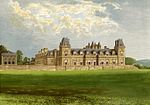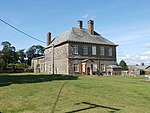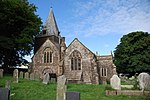St Giles in the Wood

St Giles in the Wood is a village and civil parish in the Torridge district of Devon, England. The village lies about 2.5 miles east of the town of Great Torrington, and the parish, which had a population of 566 in 2001 compared with 623 in 1901, is surrounded clockwise from the north by the parishes of Huntshaw, Yarnscombe, High Bickington, Roborough, Beaford, Little Torrington and Great Torrington. Most of the Victorian terraced cottages in the village, on the east side of the church, were built by the Rolle Estate.Within the parish are several historic residences: Stevenstone (the historic seat of the Rolle family), Way Barton (home of the Pollard family), Winscott (where Tristram Risdon, author of the Survey of Devonshire, was born, c. 1580), Dodscott and Woodleigh Barton. There are also a number of hamlets including High Bullen, Healand and Kingscott (where there is a Baptist chapel dating from 1833, and a late 19th-century school), and in the south-west of the parish is the Royal Horticultural Society's Rosemoor Garden.
Excerpt from the Wikipedia article St Giles in the Wood (License: CC BY-SA 3.0, Authors, Images).St Giles in the Wood
Torridge District
Geographical coordinates (GPS) Address Nearby Places Show on map
Geographical coordinates (GPS)
| Latitude | Longitude |
|---|---|
| N 50.951 ° | E -4.087 ° |
Address
EX38 7JH Torridge District
England, United Kingdom
Open on Google Maps







